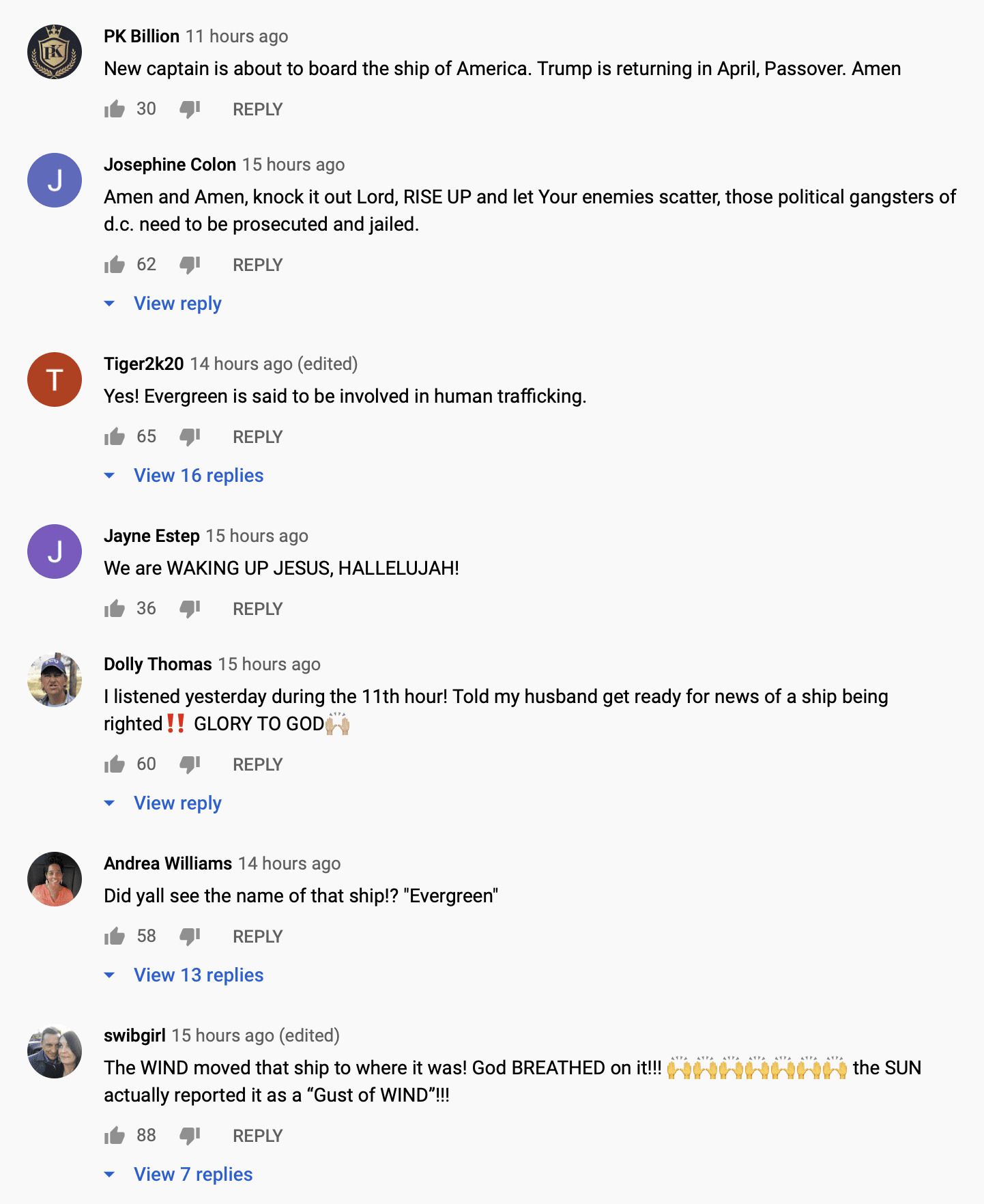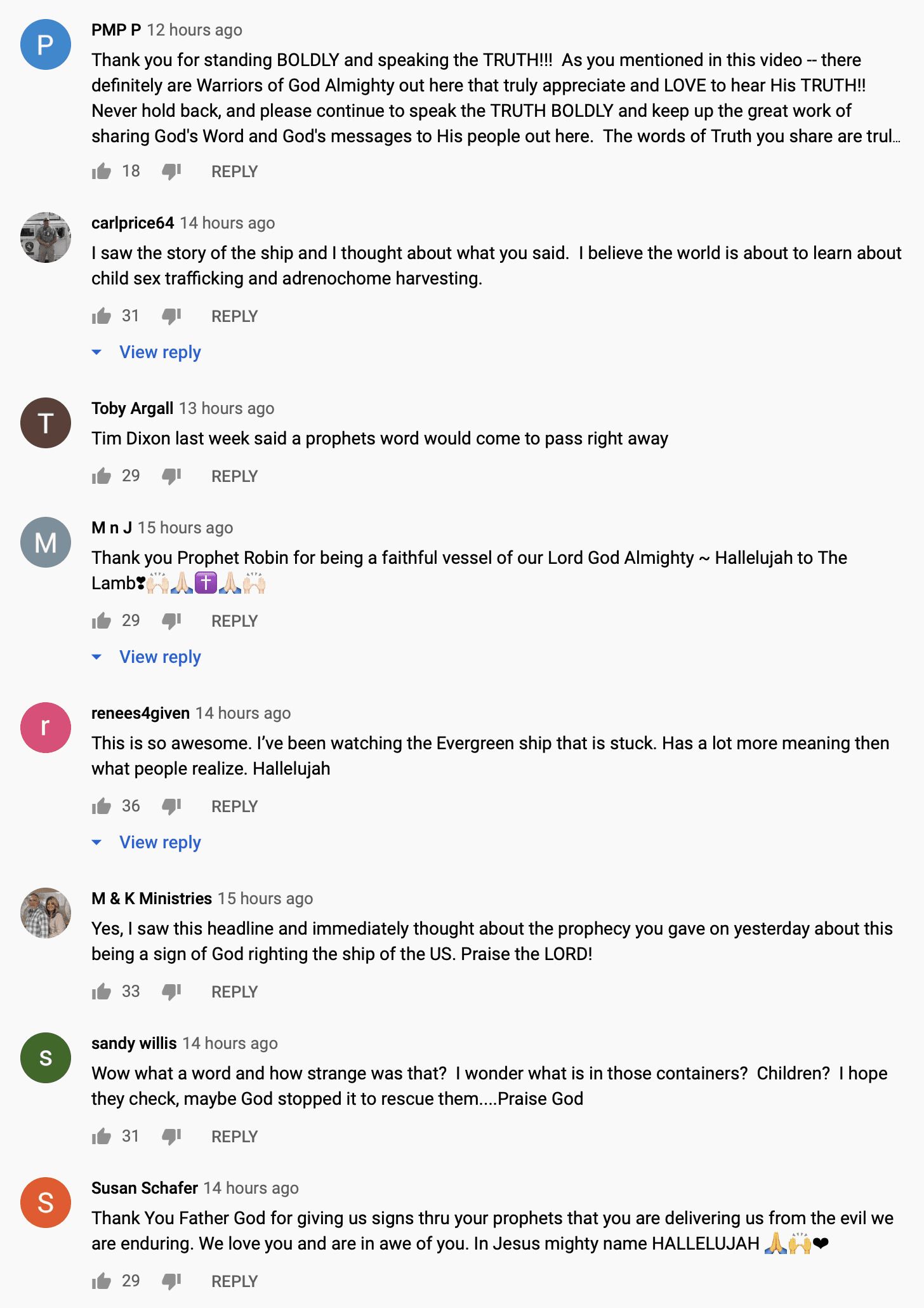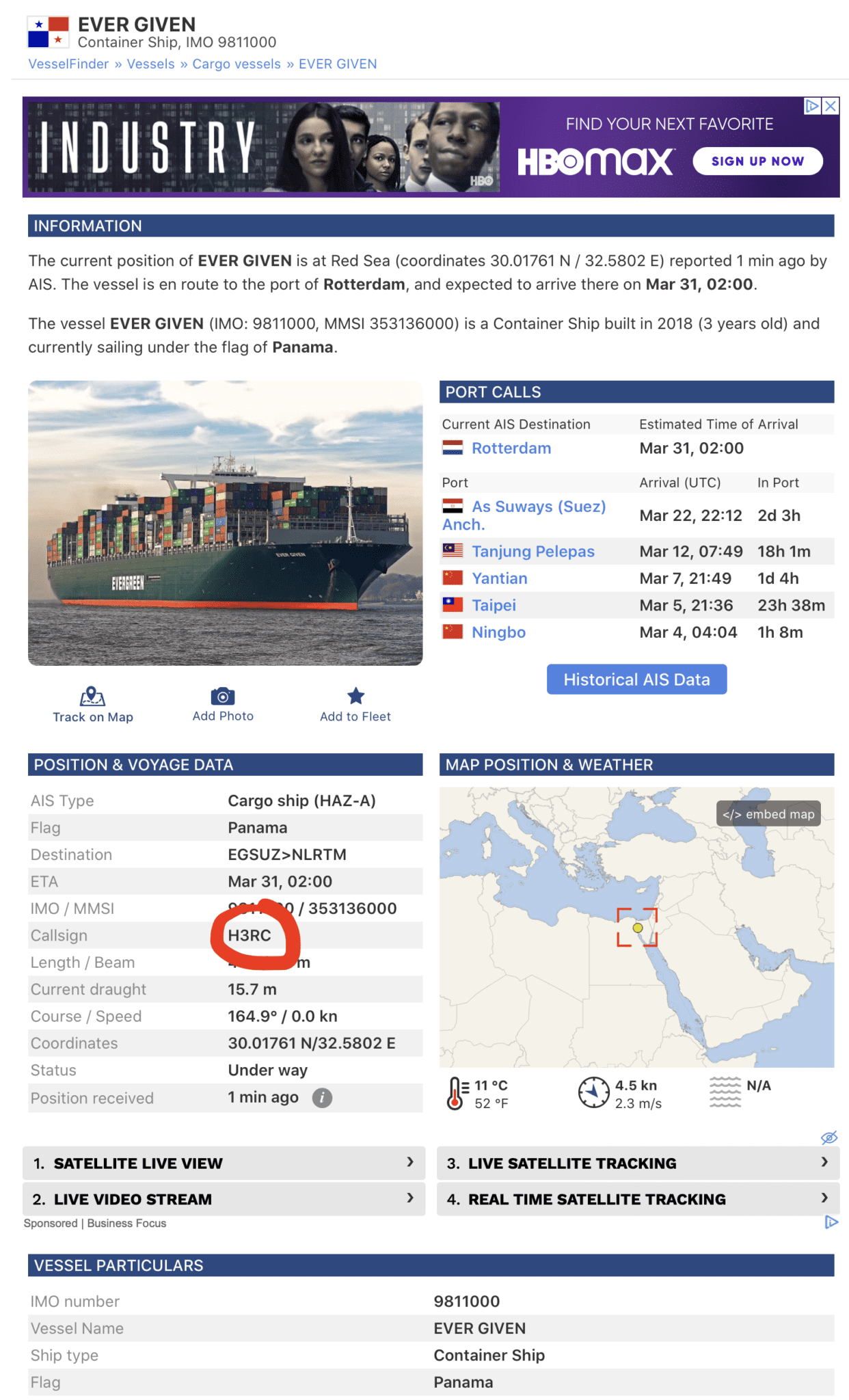Last night I brought you the stunning details of the Ever Green ship in the Suez Canal….
The details the MSM won’t tell you, like the Baraka, the H3RC, the Mossad and so much more.
Now it gets even crazier as I just found out that earlier in the day before the news even broke, Robin Bullock had a prophecy that a ship would get stuck and become big news.
Can you believe that?
It came to pass almost immediately.
God is establishing his word in Robin Bullock and others.
Watch safely here on Rumble:
Top comments:


Backup from YouTube:
Here’s my original article below with more mind-blowing details….
Did you see the news today of that giant ship stuck in the Suez Canal?
It was everywhere.
In case you missed it, check this out:
So, the #SuezCanal is blocked…
Massive container ship EVER GIVEN stuck in the most awkward way possible.
Ongoing for hours. Every tug Egypt could spare appear to be trying to pull it free.
Vessel tracker: https://t.co/MsTUgVgyTH pic.twitter.com/08w4qpPqln
— John Scott-Railton (@jsrailton) March 23, 2021
A traffic jam on the Suez Canal, like the one caused by the massive Ever Given container ship, is rather a big problem. Why is the Suez Canal so important? pic.twitter.com/8AAiHpmQUM
— Reuters (@Reuters) March 24, 2021
Interesting story I guess, but typically not something I’m covering here on WeLoveTrump.
Except…..for this.
You seriously cannot make this stuff up folks, check this out.
So the ship that got “stuck” is called the H3RC.
Remind you of anything?
HRC = Hillary Rodham Clinton.
Or as many of you affectionately refer to her, Hillary Rotten Clinton.
Now here’s where it gets good….
The ship trying to free the H3RC is the “Baraka”.
For real.
Oh, and three ships around it are called the Mosaed (Mossad) 1, 2 and 3.
Are you kidding me?
All true, take a look:
Oh shit 😂😂 The Baraka tugboat is trying to assist the stuck Evergreen ship in the Suez.. you cannot make this up.. pic.twitter.com/dvb4qUHlOw
— eastcoastal (@EastCoastalDB) March 24, 2021
https://twitter.com/kshadyacct4/status/1374533136718127105
https://twitter.com/kshadyacct4/status/1374541048068894726
I verified it myself.
From Bloomberg:
The 193-kilometer-long (120 miles) Suez Canal is among the most trafficked waterways in the world, used by oil tankers shipping crude from the Middle East to Europe and North America. About 12% of global trade and 8% of liquefied natural gas pass through the canal, as do around one million barrels of oil each day.
No progress has been made so far in floating the vessel and clearing the canal, the Gulf Agency Company, which provides services including Suez transits, said by email. Images released by the Suez Canal Authority showed the vessel’s hull firmly wedged into a banking. They also depicted efforts by the Baraka 1, one of eight tug boats deployed so far in the rescue, to try and yank the ship free.
The weight of the Ever Given — about 224,000 tons — and small size of the tug boats operated by canal authorities have hampered work so far, according to two people familiar with the situation, who asked not to be identified discussing private details. Ship owners are in talks with SMIT Salvage B.V., which has larger tugs, to assist, indicating that it may take days to clear the canal, one of the people said.
And from VesselFinder, you can verify the H3RC call signal yourself:
From The Guardian:
One of the largest container ships in the world has been partially refloated after it ran aground in the Suez canal, causing a huge jam of vessels at either end of the vital international trade artery.
The 220,000-ton, 400-metre-long Ever Given – a so-called megaship operated by the Taiwan-based firm Evergreen – became stuck near the southern end of the canal on Tuesday. The Suez Canal Authority (SCA) said it had lost the ability to steer amid high winds and a dust storm.
Eight tugboats were working to free the vessel, blocking a lane key to Asia-Europe trade through which about 50 ships a day passed in 2019, according to Egyptian government statistics.
GAC, a Dubai-based marine services company, said the Ever Given had been partially refloated and moved alongside the canal bank, citing information from the SCA.
“Convoys and traffic are expected to resume as soon as the vessel is towed to another position,” GAC said on its website.
Bernhard Schulte Shipmanagement (BSM), the ship’s technical manager, said it ran aground in the canal at about 0540 GMT on Tuesday.
BSM said all crew were safe and accounted for, and there had been no reports of injuries or pollution.
A growing number of tankers were gathering near the entrance to the canal on Wednesday morning waiting to pass through. Seven vessels carrying 6.3m barrels of crude oil were among those unable to pass, the research firm Kpler said, with another three carrying an additional 2.5m barrels scheduled to try to make the passage by the end of the week.
The accident was probably due in part to strong winds that turned the containers above deck into a vast sail that blew the vessel off course, said Jamil Sayegh, a former captain and maritime law specialist with experience navigating the canal. “The force generated by the wind would have unintentionally altered the heading of the vessel,” he said.
But he added that human error may also have been a factor since ships traverse the canal in convoys and none of the vessels behind the Ever Given had run into similar troubles.
“Ships are machines run by propulsion engines with rudders that are almost identical in all vessels. The variables on board are the software and the personnel.”
Vessels passing through the Suez are obligated to use Egyptian pilots to help them navigate the stretch, he said.
Weather forecasts would have shown that winds were strong on Wednesday, but he said both canal authorities and mariners tried not to delay passage.
“If you delay this vessel at Suez anchorage, it means you are making the ship owner to lose $60,000 [£44,000] per day or $3-4000 per hour of delay,” said Sayegh, the Beirut agent for the shipping journal Lloyd’s.
The incentive not to pause journeys had grown more acute with the rise of just-in-time supply chains in recent decades, said Peter Sand, the chief shipping analyst with Bimco, an international association for shipowners.
“For decades shipping has been the invisible conveyor belt at sea, enabling large manufacturing industries like automative to do just-in-time shipments, even though from time to time shippers are calling foul in terms of the reliability of the schedule,” he said. “Some production lines may be halted due to containers being caught in traffic like this.”
Lars Jensen, the chief executive of SeaIntelligence Consulting, said delays increased the risk of congestion at European ports. “When the canal reopens, this will mean that the delayed cargo will now arrive at the same time as cargo behind it which is still on track,” he said.
More:







Join the conversation!
Please share your thoughts about this article below. We value your opinions, and would love to see you add to the discussion!